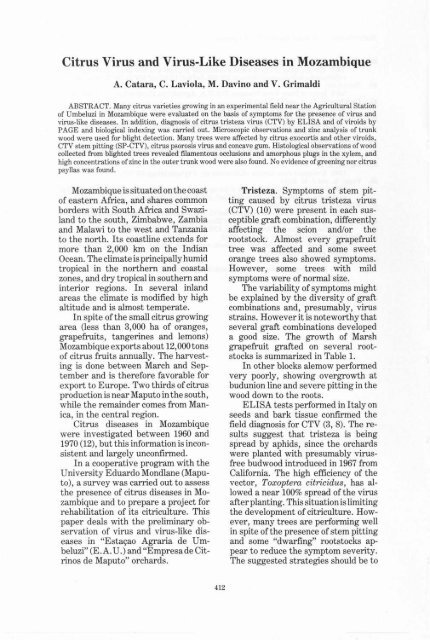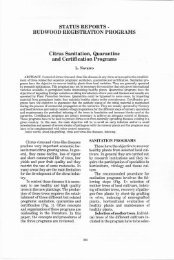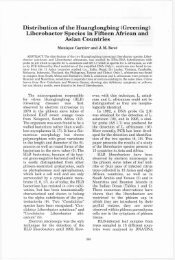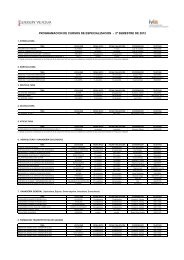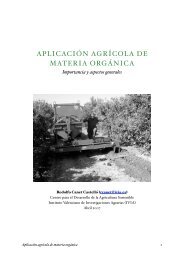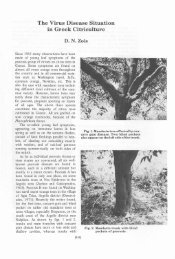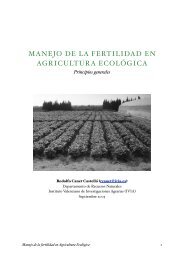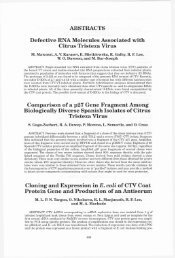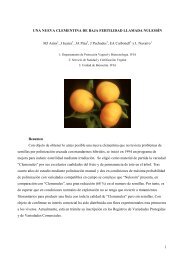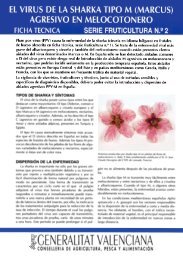A. Catara, C. Laviola, M. Davino and V. Grimaldi - IVIA
A. Catara, C. Laviola, M. Davino and V. Grimaldi - IVIA
A. Catara, C. Laviola, M. Davino and V. Grimaldi - IVIA
Create successful ePaper yourself
Turn your PDF publications into a flip-book with our unique Google optimized e-Paper software.
Citrus Virus <strong>and</strong> Virus-Like Diseases in Mozambique<br />
A. <strong>Catara</strong>, C. <strong>Laviola</strong>, M. <strong>Davino</strong> <strong>and</strong> V. <strong>Grimaldi</strong><br />
ABSTRACT. Many citrus varieties growing in an experimental field near the Agricultural Station<br />
of Umbeluzi in Mozambique were evaluated on the basis of symptoms for the presence of virus <strong>and</strong><br />
virus-like diseases. In addition, diagnosis of citrus tristeza virus (CTV) by ELISA <strong>and</strong> of viroids by<br />
PAGE <strong>and</strong> biological indexing was carried out. Microscopic observations <strong>and</strong> zinc analysis of trunk<br />
wood were used for blight detection. Many trees were affected by citrus exocortis <strong>and</strong> other viroids,<br />
CTV stem pitting (SP-CTV), citrus psorosis virus <strong>and</strong> concave gum. Histological observations of wood<br />
collected from blighted trees revealed filamentous occlusions <strong>and</strong> amorphous plugs in the xylem, <strong>and</strong><br />
high concentrations of zinc in the outer trunk wood were also found. No evidence of greening nor citrus<br />
psyllas was found.<br />
Mozambique is situated on the coast<br />
of eastern Africa, <strong>and</strong> shares common<br />
borders with South Africa <strong>and</strong> Swazil<strong>and</strong><br />
to the south, Zimbabwe, Zambia<br />
<strong>and</strong> Malawi to the west <strong>and</strong> Tanzania<br />
to the north. Its coastline extends for<br />
more than 2,000 km on the Indian<br />
Ocean. The climate is principally humid<br />
tropical in the northern <strong>and</strong> coastal<br />
zones, <strong>and</strong> dry tropical in southern <strong>and</strong><br />
interior regions. In several inl<strong>and</strong><br />
areas the climate is modified by high<br />
altitude <strong>and</strong> is almost temperate.<br />
In spite of the small citrus growing<br />
area (less than 3,000 ha of oranges,<br />
grapefruits, tangerines <strong>and</strong> lemons)<br />
Mozambique exports about 12,000 tons<br />
of citrus fruits annually. The harvesting<br />
is done between March <strong>and</strong> September<br />
<strong>and</strong> is therefore favorable for<br />
export to Europe. Two thirds of citrus<br />
production is near Maputo in the south,<br />
while the remainder comes from Manica,<br />
in the central region.<br />
Citrus diseases in Mozambique<br />
were investigated between 1960 <strong>and</strong><br />
1970 (12), but this information is inconsistent<br />
<strong>and</strong> largely unconfirmed.<br />
In a cooperative program with the<br />
University Eduardo Mondlane (Maputo),<br />
a survey was carried out to assess<br />
the presence of citrus diseases in Mozambique<br />
<strong>and</strong> to prepare a project for<br />
rehabilitation of its citriculture. This<br />
paper deals with the preliminary observation<br />
of virus <strong>and</strong> virus-like diseases<br />
in "Esta~ao Agraria de Umbeluzi"<br />
(E. A.U.) <strong>and</strong> "Empresa de Citrinos<br />
de Maputo" orchards.<br />
Tristeza. Symptoms of stem pitting<br />
caused by citrus tristeza virus<br />
(CTV) (10) were present in each susceptible<br />
graft combination, differently<br />
affecting the scion <strong>and</strong>lor the<br />
rootstock. Almost every grapefruit<br />
tree was affected <strong>and</strong> some sweet<br />
orange trees also showed symptoms.<br />
However, some trees with mild<br />
symptoms were of normal size.<br />
The variability of symptoms might<br />
be explained by the diversity of graft<br />
combinations <strong>and</strong>, presumably, virus<br />
strains. However it is noteworthy that<br />
several graft combinations developed<br />
a good size. The growth of Marsh<br />
grapefruit grafted on several rootstocks<br />
is summarized in Table 1.<br />
In other blocks alemow performed<br />
very poorly, showing overgrowth at<br />
budunion line <strong>and</strong> severe pitting in the<br />
wood down to the roots.<br />
ELISA tests performed in Italy on<br />
seeds <strong>and</strong> bark tissue confirmed the<br />
field diagnosis for CTV (3, 8). The results<br />
suggest that tristeza is being<br />
spread by aphids, since the orchards<br />
were planted with presumably virusfree<br />
budwood introduced in 1967 from<br />
California. The high efficiency of the<br />
vector, Toxoptera citricidus, has allowed<br />
a near 100% spread of the virus<br />
after planting. This situation is limiting<br />
the development of citriculture. However,<br />
many trees are performing well<br />
in spite of the presence of stem pitting<br />
<strong>and</strong> some "dwarfing" rootstocks appear<br />
to reduce the symptom severity.<br />
The suggested strategies should be to
Status Reports - Budwood Registration Programs 413<br />
TABLE 1<br />
TREE SIZE AND SCION STEM PITTING OF MARSH GRAPEFRUIT TREES GRAFTED ON<br />
DIFFERENT ROOTSTOCKS<br />
Rootstock<br />
Circumference Stempitting<br />
Sizez (em)y on scionx<br />
Bitter sweet orange<br />
Cleopatram<strong>and</strong>arin<br />
Ridge Pineapple sweel<br />
Orl<strong>and</strong>o tangelo<br />
Sampson tangelo<br />
Imperadortangerine<br />
Natal tangerine<br />
Estes rough lemon<br />
Local rough lemon<br />
Beauty Tangerine<br />
Rangpurlime<br />
Carrizo citrange<br />
Citrumelo<br />
Rubidoux trifoliate<br />
'Evaluated in comparison with "st<strong>and</strong>ard" size L = large; M = medium; S = small<br />
YDetermined 10 cm above the bud union<br />
"Rated from 0 (no stem pitting) to 2 (severe)<br />
evaluate mild strains of CTV for preimmunization,<br />
<strong>and</strong> use of alternative<br />
rootstocks to prevent rapid decline of<br />
the trees.<br />
Citrus viroid infection. Several<br />
trees of Washington navel, Valencia<br />
orange, <strong>and</strong> Eureka lemon grafted on<br />
trifoliate orange <strong>and</strong> Rangpur lime<br />
showed symptoms of exocortis. Sister<br />
plants grafted on trifoliate orange hybrids<br />
showed slightly reduced growth,<br />
probably as a consequence of infection.<br />
Results of PAGE tests carried out on<br />
samples of young bark of Washington<br />
navel, Valencia late orange, Eureka<br />
lemon <strong>and</strong> Mexican lime revealed the<br />
presence of citrus exocortis viroid<br />
(CEVd). Other viroids were found in<br />
most of the samples, either alone or<br />
associated in different combinations<br />
(7).<br />
The occurrence of exocortis might<br />
restrict the use of several rootstocks<br />
such as trifoliate orange <strong>and</strong> its hybrids,<br />
unless healthy propagative material<br />
is provided. However, the opportunity<br />
to utilize propagative materials<br />
previously inoculated with wellcharacterized<br />
dwarfing strains of viroids<br />
might be possible, considering the<br />
experience of other countries (4,6,13).<br />
In this respect, the biological <strong>and</strong><br />
biochemical characterization of viroids<br />
infecting citrus in Mozambique is required.<br />
Blight. Symptoms resembling<br />
blight (2) were noted in some orchards.<br />
The affected trees of sweet orange on<br />
rough lemon showed dieback, partial<br />
defoliation, lack of new growth flushes,<br />
zinc deficiency-like symptoms on the<br />
leaves <strong>and</strong> scattered distribution in the<br />
field. The occurrence of citrus blight in<br />
neighbouring South Africa <strong>and</strong> Swazil<strong>and</strong><br />
(9) suggested the possibility of<br />
blight. Water uptake attempts were<br />
negative probably because of the poor<br />
cultivation <strong>and</strong> inappropriate season<br />
(July). Light <strong>and</strong> scanning electron<br />
microscopy tests (1) were performed<br />
on samples of trunk wood detached at<br />
a depth of 2 cm from the cambium <strong>and</strong><br />
5 cm above the bud union. Unstained<br />
sections revealed in some samples arelatively<br />
large number of amorphous<br />
plugs, naturally appearing yellow or<br />
amber in colour <strong>and</strong> located over the<br />
length of vessel lumens or only at the<br />
junction of xylem vessels. The brown<br />
fibrous plugs were also noted (Figs. 1<br />
<strong>and</strong> 2). Scanning electron microscopy<br />
(Figs. 3 <strong>and</strong>4) detected the typical compact<br />
amorphous plugs <strong>and</strong> branching<br />
<strong>and</strong> elongated filamentous plugs along<br />
the vessel walls (5). Wood samples<br />
from symptomatic plants contained a
Twelfth ZOCV Conference<br />
Fig. 1-4. Light micrographs of unstained wood tissue containing amorphorus (a) <strong>and</strong> fibrous<br />
(f) plugs in transversal (Fig. 1: bar = 100 pm) <strong>and</strong> longitudinal sections (Fig. 2: bar 100 = pm).<br />
Scanning electron microscopy of wood tissue containing amorphorus (Fig. 3: bar = 50pm) <strong>and</strong><br />
filamentous (Fig. 4: bar = 50,pm) plugs of xylem vessels.
Status Reports - Budwood Registration Programs 415<br />
higher content of zinc (15.2 ppm) in<br />
comparison to the normal looking<br />
plants (4.3 ppm), (Table 2) thus confirming<br />
the presence of blight.<br />
Psorosis. Psorosis bark scaling<br />
symptoms were widely present on<br />
Washington navel orange in both<br />
E.A.U. <strong>and</strong> Empresa de Citrinos, <strong>and</strong><br />
on Marsh grapefruit, m<strong>and</strong>arin <strong>and</strong><br />
local orange cultivars in the E.A. U..<br />
TABLE 2<br />
ZINC CONTENT IN WOOD SAMPLES OF<br />
SWEET ORANGE TREES GRAFTED ON<br />
ROUGH LEMON<br />
Trees<br />
Healthy looking<br />
1<br />
3<br />
4<br />
Symptomatic<br />
1<br />
2<br />
3<br />
4<br />
5<br />
6<br />
Zinc content (ppm)<br />
individual mean<br />
Psorosis was widespread in most citrus<br />
areas since symptoms were observed<br />
in 30-yr-old Washington navel orange<br />
trees, which were previously used as<br />
bud sources.<br />
Concave gum. Symptoms of concave<br />
gum were observed on Marsh<br />
grapefruit, Washington navel orange,<br />
local orange cultivars <strong>and</strong> m<strong>and</strong>arins.<br />
Trees on trifoliate orange often also<br />
had exocortis symptoms. This is the<br />
first report of concave gum in southern<br />
Africa.<br />
Greening. Symptoms of greening<br />
(leaf mottling) (14) were not observed,<br />
despite the fact that the disease has<br />
been reported in other states around<br />
Mozambique, namely South Africa,<br />
Swazil<strong>and</strong>, Madagascar <strong>and</strong> the Reunion<br />
Isl<strong>and</strong>s (9, 11). Evidence of Trioza<br />
erytreae, the vector of greening in<br />
South Africa <strong>and</strong> Swazil<strong>and</strong> was not<br />
found. The climate in southern Mozambique<br />
is unsuitable for both greening<br />
<strong>and</strong> the vector, but the cooler Manica<br />
region could be vulnerable.<br />
Diaphorina citri, the vector of Asian<br />
greening, has not been reported in<br />
Mozambique.<br />
LITERATURE CITED<br />
1. Brlansky, R. H., R. F. Lee, <strong>and</strong> M. H. Collins 1985. Structural comparison of xylem occlusions<br />
inthe trunksof citrus trees with blight<strong>and</strong>otherdeclinediseases. Phytopathology 75: 145-150.<br />
2. Cohen, M., <strong>and</strong> H. K. Wutscher<br />
1977. Diagnosisoftreeswithcitrusblight (YTD). In: Proc. Int. Soc. Citriculture3: 884-886.<br />
3. <strong>Davino</strong>, M., R. Areddia, L. Pelicani, <strong>and</strong> V. <strong>Grimaldi</strong><br />
1991. Indexing of seeds of different citrus species for tristeza <strong>and</strong> variegation viruses, p.<br />
368-372. In: Proc llth Conf. IOCV. IOCV, Riverside.<br />
4. Gillings, M. R., P. Broadbent, <strong>and</strong> B. I. Gillnow<br />
1991. Viroids in Australian citrus: relationship to exocortis, cachexia <strong>and</strong> citrus dwarfing.<br />
Austral. J. Plant Physiol. 18: 559-570.<br />
5. <strong>Grimaldi</strong>, V., A. <strong>Catara</strong>, <strong>and</strong> 0. Leonardi<br />
1993. Scanning electron <strong>and</strong> light microscopy of citrus blighted trees in Mozambique. Riv.<br />
Pat. Veg. S V, 3: 7-14.<br />
6. Hadas, R., <strong>and</strong> M. BarJoseph<br />
1991. Variation in tree size <strong>and</strong> rootstock scaling of grapefruit trees inoculated with a complex<br />
of citrus viroids, p. 240-243. In: Proc. llth Conf. IOCV. IOCV, Riverside.<br />
7. La Rosa, R., G. Albanese, M. Renis, <strong>and</strong> A. <strong>Catara</strong><br />
1988. Viroids <strong>and</strong> viroid-like RNAs in citrus plants. In: Proc. 6th Int. Citrus Congress, 3:<br />
903-907.<br />
8. <strong>Laviola</strong>, C., M. <strong>Davino</strong>, <strong>and</strong> A. M. Mondjane<br />
Presenca do virus da tristeza en Mocambique. INIA, Mocambique. (in press).<br />
9. Lee, R. F., L. J. Marais, <strong>and</strong> R. H. Brlansky<br />
1983. A survey for citrus blight in South Africa, p. 270-278. In: Proc. 9th Conf. IOCV. IOCV,<br />
Riverside.<br />
10. McClean, A. P. D.<br />
1963. The tristeza virus complex: Its variability in field-grown citrus in South Africa. S. Afr.<br />
J. Agr. Sci. 6: 303-332.
416 Twelfth IOCV Conference<br />
11. Oberholzer, P. C. J., D. F. A. Von Staden, <strong>and</strong> W. J. Basson<br />
1965. Greening disease of sweet orange in South Africa, p. 213-219. In: Proc. 3rd Conf. IOCV.<br />
Univ. Florida Press, Gainesville.<br />
12. Plumb-Dhindsa, P., <strong>and</strong> A. M. Mondjane<br />
1984. Index of plant diseases <strong>and</strong> associated organisms of Mozambique. Trop. Pest Manag.<br />
30: 407-429.<br />
13. Roistacher, C. N., J. E. Pehrson, <strong>and</strong> J. S. Semancik<br />
1991. Effect of citrus viroids <strong>and</strong> the influence of rootstocks on field performance of navel<br />
orange, p. 234-239. In: Proc. 11th conf. IOCV. IOCV, Riverside.<br />
14. Schwarz, R. E., <strong>and</strong> J. M. Bov6<br />
1980. Greening. In: J. M. Bove & R. Vogel (eds.). Virus <strong>and</strong> virus-like disease of citrus. A<br />
collection of colour slides, Vol. I. IRFA- Setco, Paris.


